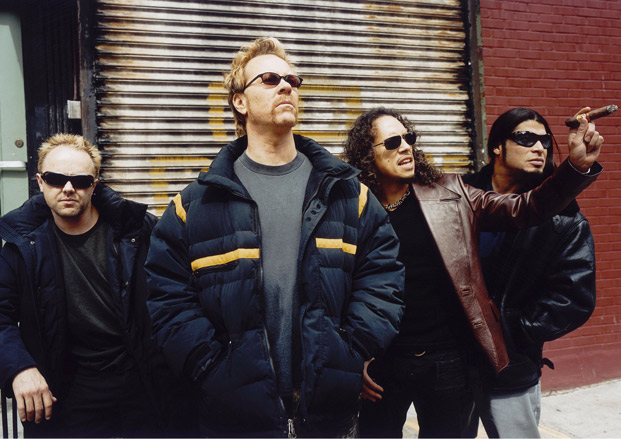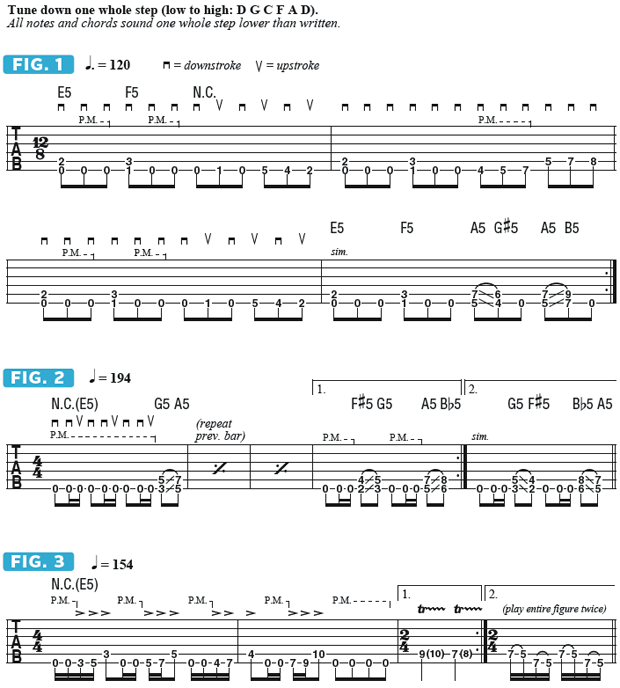Play Mega-Metal Licks in the Style of Metallica, Testament and Pantera

I’d like to focus on riffs and rhythm ideas that represent what I think of as “the real deal” metal.
I’ve designed these riffs to help you build up both your pick-and fret-hand technique in regard to executing pure metal ideas like these with power and precision.
FIGURE 1 is inspired by the heavy riffs of Testament and Pantera and is built from combining a few different scales, such as E major (E F# G# A B C# D#) and E Phrygian-dominant (E F G# A B C D), with sliding two-note power chords.
Across beats one and two, I begin with two-note E5 and F5 power chords that alternate against open low E string accents, all of which are executed with aggressive down-strokes.
Across beats three and four, I switch to alternate (down-up) picking. In bar 2, I begin with the same figure over the first two beats, but I switch to a higher single-note riff for beats three and four, one that moves from E major to E Phrygian-dominant. In bar 3 I repeat the figure from bar 1, which I then follow with sliding two-note power chords, fretted on the bottom two strings, first sliding down one half step, from A5 to G#5, and then up one whole step, from A5 to B5.
FIGURE 2 is inspired by some of Testament’s heavy rhythm parts, such as the one heard in “Over the Wall,” and utilizes a classic metal “gallop” rhythm, which is an eighth note followed by two 16ths. This type of gallop rhythm was previously popularized by Iron Maiden, who used it on many of their biggest songs, such as “Run to the Hills.”
The gallop figure shown here is executed with fast downdown-up picking in conjunction with palm muting on beats one through three, followed by eighth-note sliding power chords. This example is played at a rather quick tempo—194 beats per minute—and practicing it at that tempo will definitely add strength and precision to your pick-hand technique.
You’ll hear sliding power chord figures like these on Metallica’s “Master of Puppets” as well as Pantera’s “Mouth for War.” For our last example, FIGURE 3, I’ve put together a riff comprised entirely of single notes, and I intentionally made it obscure in terms of outlining a specific tonality. Though the open low E note is accentuated, creating a connection to E5 or E minor, the notes themselves do not stick within the structure of any scale. My goal was simply to come up with a cool, heavy-sounding riff that features a few different articulation techniques.
Through all of bar 1 and the first half of bar 2, I repeatedly play pairs of open low E accents in 16th notes, followed by a variety of three-note melodic shapes. Bar 3 presents a shift to 2/4 meter for the fast trills, after which bars 1 and 2 are repeated. The riff ends with quick pull-off phrases on the bottom two strings, fretted with the index and ring fingers. Apply these techniques to some heavily brutal metal riffs of your own design and have fun with them!

Get The Pick Newsletter
All the latest guitar news, interviews, lessons, reviews, deals and more, direct to your inbox!
“There are so many sounds to be discovered when you get away from using a pick”: Jared James Nichols shows you how to add “snap, crackle and pop” to your playing with banjo rolls and string snaps
Don't let chord inversions bamboozle you. It's simply the case of shuffling the notes around







![Joe Bonamassa [left] wears a deep blue suit and polka-dotted shirt and plays his green refin Strat; the late Irish blues legend Rory Gallagher [right] screams and inflicts some punishment on his heavily worn number one Stratocaster.](https://cdn.mos.cms.futurecdn.net/cw28h7UBcTVfTLs7p7eiLe.jpg)


